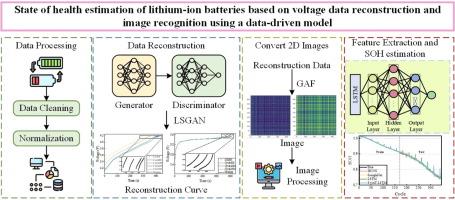电池SOH增强解决方案:电压重建和图像识别响应的数据丢失场景
IF 14.9
1区 化学
Q1 Energy
引用次数: 0
摘要
电池健康状态的准确估计在电池管理系统中起着至关重要的作用。然而,运行数据的缺乏仍然影响着电池健康状态(SOH)估计的准确性。为此,提出了一种基于收费数据重构与图像处理相结合的SOH估计方法。利用充电电压数据训练最小二乘生成对抗网络(LSGAN),并在不同程度的缺失数据下对其进行了验证。从视觉上看,采用革兰角场法将一维时间序列数据转换为图像数据。该方法充分保留了特征的时间序列特征和非线性演化模式,避免了人工特征提取的困难和有限的表达能力。同时,引入Swin Transformer模型从图像中提取全局结构和局部细节,从而更好地捕捉序列变化趋势。结合长短期记忆网络(LSTM),可以准确估计电池SOH。两种不同类型的电池被用来验证测试。实验结果表明,在不同的训练比例下,该方法具有较好的估计精度。本文章由计算机程序翻译,如有差异,请以英文原文为准。

Battery SOH enhanced solution: Voltage reconstruction and image recognition response to loss of data scenarios
Accurate estimation of battery health status plays a crucial role in battery management systems. However, the lack of operational data still affects the accuracy of battery state of health (SOH) estimation. For this reason, a SOH estimation method is proposed based on charging data reconstruction combined with image processing. The charging voltage data is used to train the least squares generative adversarial network (LSGAN), which is validated under different levels of missing data. From a visual perspective, the Gram angle field method is applied to convert one-dimensional time series data into image data. This method fully preserves the time series characteristics and nonlinear evolution patterns, which avoids the difficulties and limited expressive power associated with manual feature extraction. At the same time, the Swin Transformer model is introduced to extract global structures and local details from images, enabling better capture of sequence change trends. Combined with the long short-term memory network (LSTM), this enables accurate estimation of battery SOH. Two different types of batteries are used to validate the test. The experimental results show that the proposed method has good estimation accuracy under different training proportions.
求助全文
通过发布文献求助,成功后即可免费获取论文全文。
去求助
来源期刊

Journal of Energy Chemistry
CHEMISTRY, APPLIED-CHEMISTRY, PHYSICAL
CiteScore
19.10
自引率
8.40%
发文量
3631
审稿时长
15 days
期刊介绍:
The Journal of Energy Chemistry, the official publication of Science Press and the Dalian Institute of Chemical Physics, Chinese Academy of Sciences, serves as a platform for reporting creative research and innovative applications in energy chemistry. It mainly reports on creative researches and innovative applications of chemical conversions of fossil energy, carbon dioxide, electrochemical energy and hydrogen energy, as well as the conversions of biomass and solar energy related with chemical issues to promote academic exchanges in the field of energy chemistry and to accelerate the exploration, research and development of energy science and technologies.
This journal focuses on original research papers covering various topics within energy chemistry worldwide, including:
Optimized utilization of fossil energy
Hydrogen energy
Conversion and storage of electrochemical energy
Capture, storage, and chemical conversion of carbon dioxide
Materials and nanotechnologies for energy conversion and storage
Chemistry in biomass conversion
Chemistry in the utilization of solar energy
 求助内容:
求助内容: 应助结果提醒方式:
应助结果提醒方式:


